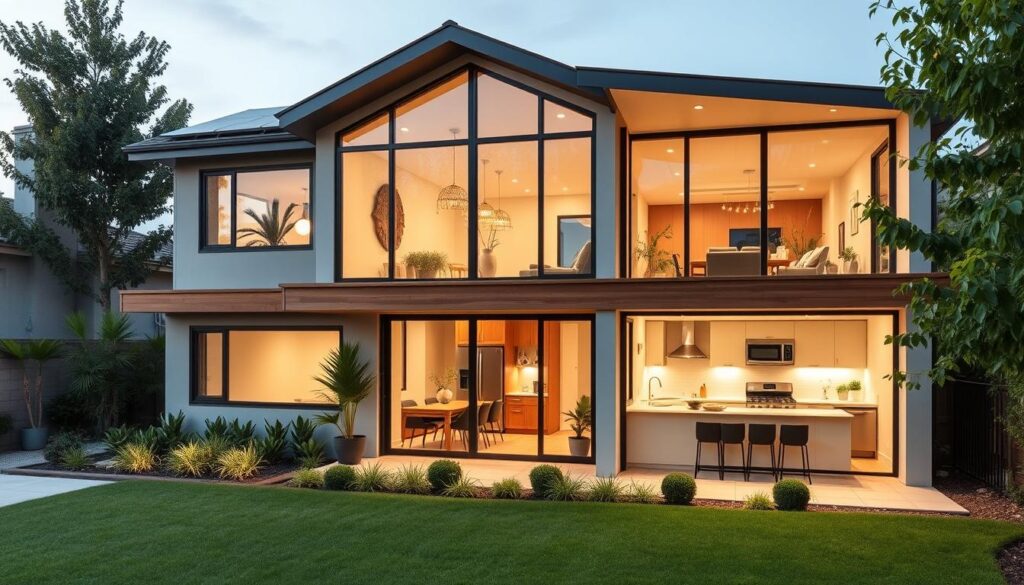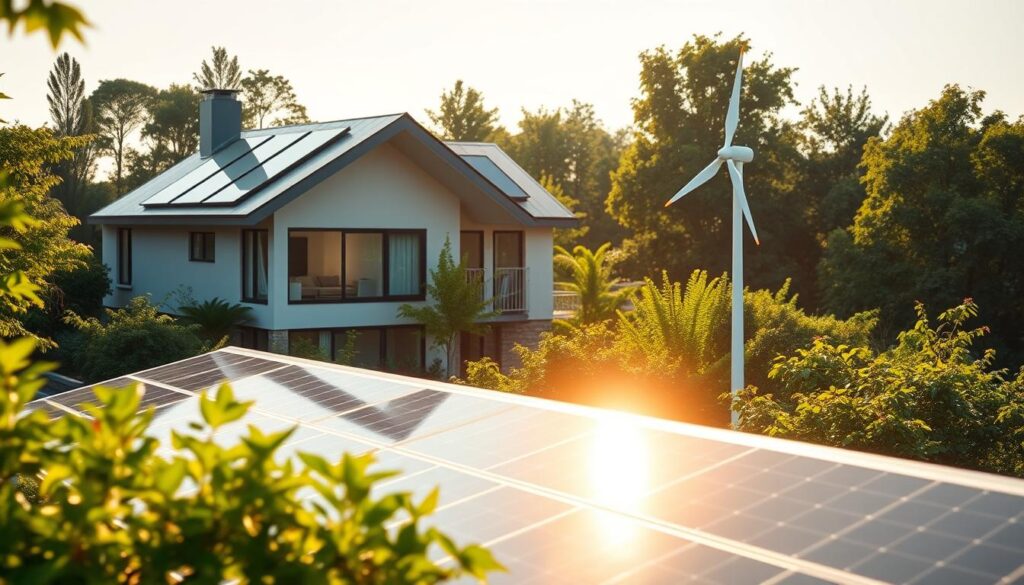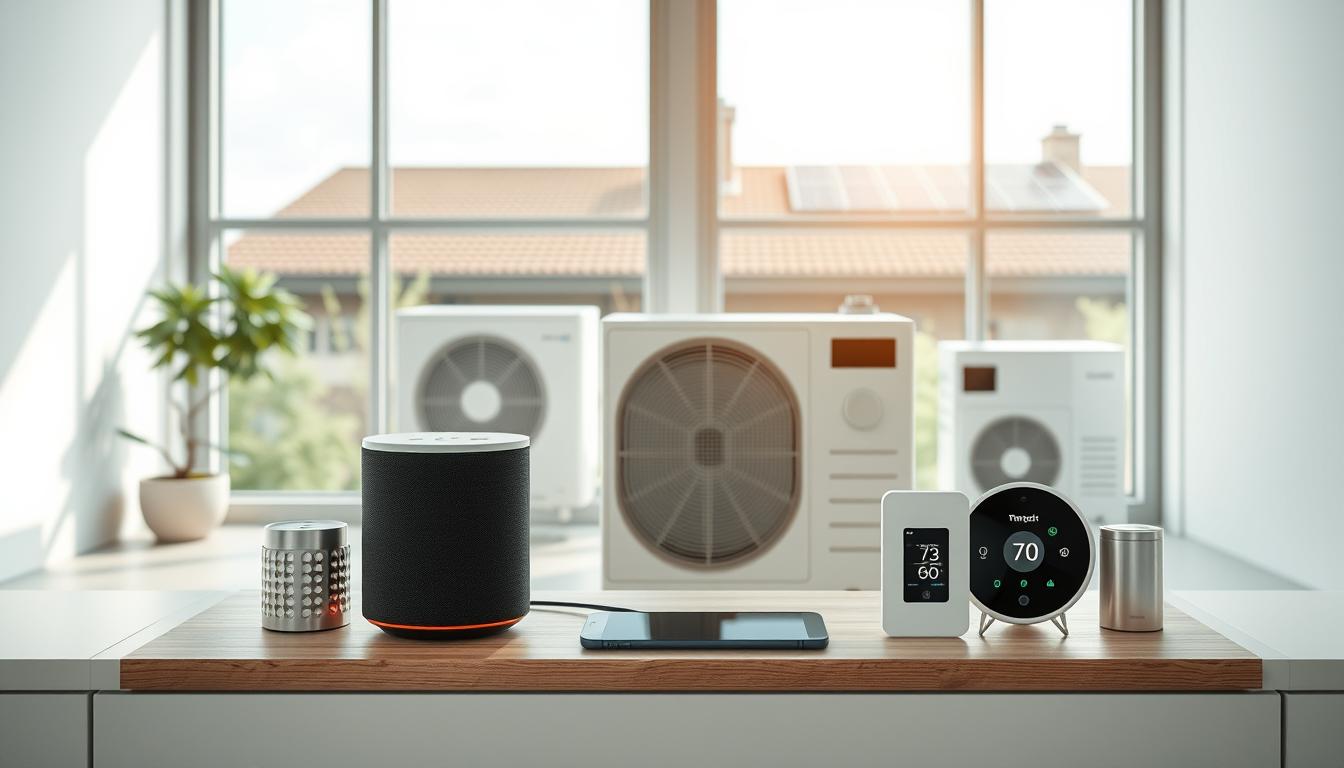Imagine a home where technology and sustainability work together to make life easier while protecting the planet. Eco-friendly gadgets for home are no longer a niche trend—they’re becoming essential tools for modern living. From smart thermostats that save energy to solar-powered devices that cut costs, these innovations blend convenience with environmental responsibility.
Key Takeaways
- 7 must-have gadgets redefine how we approach eco-conscious home design.
- Eco-friendly gadgets for home reduce energy use without sacrificing comfort.
- Modern technology aligns with sustainability to lower utility bills and carbon footprints.
- Smart systems like LED lighting and solar chargers lead the shift toward green living.
- These devices offer long-term benefits for both homeowners and the environment.
Introduction to Eco-Friendly Living
Making homes greener starts with simple choices. Eco-friendly living focuses on reducing waste, saving resources, and choosing products that care for the planet. Sustainable home gadgets are key to this shift, blending practicality with environmental responsibility.
Understanding Sustainability
Sustainability means meeting today’s needs without harming future generations. For homes, this means using energy wisely and opting for products designed to last. Recycled materials and low-energy appliances cut waste and costs. These changes add up to a healthier planet.
Green Technology Trends
- Solar-powered chargers and LED lighting systems from brands like Philips and EcoFlow.
- Smart thermostats like Nest automatically adjust heating, saving energy.
- Water-saving devices reduce usage without sacrificing convenience.
These trends show how tech meets eco-conscious goals. Innovations in materials and energy use make it easier than ever to adopt sustainable home gadgets. Every small change contributes to bigger impacts.
Home Automation: Revolutionizing Modern Living
Home automation blends convenience with environmental care through green living technology. Smart systems adjust energy use automatically, ensuring homes operate efficiently without sacrificing comfort. From lighting to climate control, these innovations turn everyday tasks into eco-friendly routines.
Popular devices like Nest thermostats and Philips Hue lighting systems learn user habits to cut energy waste. Automated irrigation controllers, such as Rachio, water gardens only when needed, saving water. These tools don’t just save resources—they lower bills while promoting sustainability.
- Smart thermostats reduce heating/cooling waste
- Automated lighting systems use motion sensors to limit unnecessary power use
- Water management systems prevent over-usage of natural resources
| Device | Feature | Eco-Benefit |
|---|---|---|
| Smart Thermostats | Adaptive temperature control | Cuts 10-15% energy use annually |
| Automated Lighting | Motion-activated LEDs | Reduces electricity consumption by 30% |
| Water Sensors | Leak detection and scheduling | Saves up to 40% water |
Integrating these systems creates a cohesive network where devices work together to minimize environmental impact. As technology evolves, these solutions become more accessible, helping households embrace sustainability effortlessly.
Energy Efficiency and Smart Home Integration
Smart homes are transforming how we save energy. Environmentally friendly home devices like smart thermostats and LED lights make cutting energy use easy. These gadgets adapt to daily routines, ensuring efficiency without sacrificing comfort.
Leading brands such as Nest and Philips Hue offer solutions that integrate seamlessly. Below compares two key categories:
| Device Type | Energy Saved | Annual Cost Savings |
|---|---|---|
| Smart Thermostats | 10–15% | $100–$200 |
| LED Lighting Systems | 75% | $50–$100 |
Smart Thermostats and LED Lighting
Nest Learning Thermostats track schedules and adjust temperatures automatically. They reduce heating costs by learning family routines. Philips Hue LED bulbs use 80% less energy than traditional bulbs and last up to 15 years. Pairing them with smart dimmers cuts energy waste further.
Maximizing Energy Savings
- Set schedules for heating and lighting via smartphone apps
- Use motion sensors to turn off lights in unused rooms
- Combine with solar panels for full system efficiency
These steps turn any home into an energy-saving hub. Environmentally friendly home devices pay for themselves over time while shrinking your carbon footprint. Start small and watch savings grow!
Designing a Sustainable Home Environment
Creating a sustainable home starts with thoughtful design choices that blend functionality with eco-conscious materials. Opt for energy-efficient home appliances like LG’s InstaView refrigerators or Samsung’s smart washing machines, which save water and power without sacrificing performance. These innovations reduce environmental impact while fitting seamlessly into modern aesthetics.
- Use recycled materials for flooring and countertops to cut waste.
- Maximize natural light with large windows, lowering reliance on artificial lighting.
- Choose energy-efficient home appliances certified by Energy Star for guaranteed savings.

“Sustainability isn’t a trend—it’s a blueprint for living smarter.” – Jane Carter, Green Design Institute
Open layouts and modular furniture optimize space, reducing the need for excess energy-consuming devices. Pairing energy-efficient appliances with solar-powered charging stations amplifies savings. Even small changes, like swapping traditional bulbs for Philips LED lights, multiply over time. Prioritize appliances with smart sensors that adjust energy use based on real-time needs. By integrating these elements, homes become both eco-friendly and inviting spaces where style and responsibility coexist.
Eco-friendly gadgets for home: Enhancing Daily Efficiency
Modern eco-conscious home products blend innovation with practicality, making sustainability effortless. These tools save time and resources while reducing environmental impact.
Cutting-Edge Innovations
Recent advancements bring fresh solutions to daily tasks. Consider solar-powered gadgets like the EcoFlow Delta Power Station, which stores renewable energy for off-grid use. Smart water sensors, such as those by Flume, track usage and alert leaks, cutting waste. Voice-controlled devices, like the Philips Hue Smart Bridge, adjust lighting automatically, saving energy without effort.
User-Friendly Features in Green Gadgets
These gadgets prioritize ease of use alongside their eco benefits. Features include:
- Mobile apps for real-time energy monitoring
- One-touch setup for quick installation
- Compatibility with existing smart home systems
Products like the August Smart Lock integrate with voice assistants, simplifying security and energy management. Even small appliances, such as the Bluberi Air Fryer with energy-efficient modes, prove sustainability doesn’t require complexity.
Innovations in Environmentally Friendly Home Devices
Today’s green home tech solutions push boundaries with cutting-edge designs. From solar-powered gadgets to AI-driven systems, these devices merge convenience with sustainability. Companies like Tesla and Philips are leading the charge, offering products that slash energy use without sacrificing performance.

- Solar-Powered Chargers: Brands like Goal Zero now provide portable solar panels, turning sunlight into power for phones and small appliances.
- Smart Water Sensors: Products from companies like Flume monitor household water usage, alerting users to leaks or overuse instantly.
- AI Thermostats: Nest and Ecobee models learn user habits, adjusting temperatures automatically to save energy.
“The next wave of smart home tech is designed to be both intuitive and planet-positive,” says a 2023 report by the Environmental Technology Institute. “These tools empower homeowners to act on sustainability daily.”
Recent advancements also include composting appliances, like the Vitamix FoodCycler, which reduces kitchen waste by 90%. Voice-activated assistants, such as Amazon Alexa, now integrate with eco-mode settings to optimize energy use. These green home tech solutions aren’t just trends—they’re practical steps toward greener living. Innovations like self-charging lights and biodegradable smart plugs prove that sustainability and style can coexist. As tech evolves, so do opportunities to protect the planet while enjoying modern comforts.
Affordable Solutions for Energy-Efficient Living
Going green doesn’t mean spending big. Eco-friendly household innovations now offer budget-friendly options that cut costs and help the planet. Start small with upgrades that fit any budget.
Budget-Friendly Eco Upgrades
Begin with simple swaps. Replace traditional bulbs with Philips Hue LED lights or plug devices into TP-Link Kasa smart plugs to manage energy use. Solar-powered chargers like EcoFlow’s Delta 1300 and low-flow showerheads cost under $50 but save water and electricity. Even LG’s Energy Star-certified appliances reduce utility bills without premium pricing.
Long-Term Savings Benefits
- LED bulbs cut lighting costs by 80% over time.
- Smart thermostats like Nest learn routines, trimming heating/cooling expenses by 10-15% yearly.
- Water-saving fixtures slash monthly bills and reduce waste.
These upgrades pay for themselves. Tax rebates and lower utility bills mean savings start now. Small changes add up—investing in eco-friendly household innovations today builds a greener, more affordable future.
Integrating Green Living Technology with Modern Design
Modern homes today prioritize both style and sustainability. Sustainable living gadgets now blend seamlessly into contemporary spaces, proving eco-friendly tech doesn’t sacrifice aesthetics. Brands like IKEA and Philips offer sleek solar-powered lights and smart thermostats that fit effortlessly into minimalist designs.
- Smart windows that adjust tint using solar energy, reducing cooling costs while enhancing curb appeal.
- 3D-printed furniture made from recycled plastics, combining durability and eco-conscious materials.
- Wireless charging pads powered by kinetic energy from foot traffic, hidden under stylish floor tiles.
“Design and sustainability are no longer opposing forces—they’re collaborative partners in innovation.”
Architects now use AI-driven software to optimize home layouts for natural light and airflow, cutting energy use without altering visual harmony. Companies like Tesla’s Solar Roof tiles exemplify this fusion, merging renewable energy with sleek roofing designs. From voice-controlled garden sprinklers to bamboo-based smart speakers, these sustainable living gadgets prove eco-tech can elevate home aesthetics. By choosing multifunctional, visually appealing solutions, homeowners can create spaces that are both beautiful and planet-positive.
The Benefits of Eco-conscious Home Products
Choosing eco-conscious home products isn’t just about trends—it’s a step toward a healthier, greener lifestyle. These innovations improve living spaces while safeguarding the planet. From cleaner air to energy savings, their benefits extend far beyond convenience. Let’s explore how these solutions enrich both personal well-being and environmental stewardship.
Health and Wellness Advantages
Many eco-friendly gadgets directly enhance daily health. Air purifiers filter out allergens, while toxin-free furniture reduces chemical exposure. Smart sensors monitor indoor air quality, alerting users to adjust ventilation. Even simple choices, like bamboo kitchenware or natural cleaning supplies, cut exposure to harmful substances. These changes create safer, toxin-free environments for families.
Reduced Carbon Footprint
Switching to eco-conscious products lowers energy use and waste. Solar chargers and LED lighting slash electricity demand, trimming carbon emissions. Even small upgrades, like water-efficient showerheads, save resources over time. By prioritizing longevity and recyclability, these items reduce landfill waste, fostering a circular economy.
Every upgrade matters. Replacing old appliances with energy-star certified models or using reusable containers cuts both pollution and costs. Small steps add up to lasting change, proving sustainability and comfort go hand in hand.
Key Considerations for Sustainable Home Gadgets
Picking the right eco-friendly gadgets starts with knowing what to look for. Quality, certifications, and tech features all shape a product’s true sustainability. Here’s how to spot the best options for your home.
Assessing Product Quality
Check how gadgets are made. Look for durable builds and materials like recycled aluminum or bamboo. Brands like Philips and EcoSmart use long-lasting designs to cut down on waste. Avoid flimsy plastics or gadgets that need frequent replacement.
Environmental Impact and Certifications
Third-party certifications prove a gadget’s eco-claims. Look for:
- Energy Star ratings for energy use
- Cradle to Cradle Certified materials
- RoHS compliance for no toxic parts
“Certifications like Energy Star ensure devices meet strict eco-standards.”
Bridging Technology and Sustainability
Smart tech can boost eco-friendliness. Devices like Nest thermostats or Belkin smart plugs track energy use in real time. Choose gadgets with solar charging or low-power modes to save resources without sacrificing convenience.
Conclusion
Eco-friendly gadgets open doors to energy-efficient living without sacrificing comfort. Innovations like smart thermostats and solar-powered devices make it easier to reduce environmental impact while saving money. Leading brands offer certified products, such as Energy Star-rated appliances, ensuring quality and sustainability.
Small steps count—upgrading to LED lighting or using smart home tech can lead to long-term savings and a healthier home. Prioritizing certified sustainable upgrades empowers households to contribute to a greener future. Start with affordable options and gradually integrate green technology to see both personal and planetary benefits.
Making eco-conscious choices today builds a foundation for smarter, sustainable living. Whether through smart home integration or energy-saving devices, every decision moves us closer to a balanced future. Explore these solutions and take the first step toward a more eco-friendly lifestyle now.
FAQ
What are some examples of eco-friendly gadgets for home use?
Examples of eco-friendly gadgets include smart thermostats, energy-efficient LED lighting, solar-powered chargers, and composting devices. These innovations help you save energy and reduce your carbon footprint while making daily tasks easier.
How do sustainable home gadgets promote green living?
Sustainable home gadgets promote green living by utilizing energy-efficient technologies, reducing waste, and encouraging eco-conscious choices. Devices like energy-monitoring systems and eco-friendly appliances work together to create a more sustainable lifestyle.
Can eco-conscious home products really save me money?
Absolutely! Many eco-conscious home products, such as energy-efficient appliances and smart home devices, can reduce your utility bills over time. They may have a higher upfront cost but will lead to long-term savings through lower energy consumption.
Are there affordable solutions for integrating energy-efficient gadgets into my home?
Yes! There are many budget-friendly options available, such as replacing traditional light bulbs with LED bulbs, using smart plugs to monitor energy use, and investing in low-cost weather stripping to improve home insulation.
How can I assess the quality of sustainable home gadgets?
When assessing the quality of sustainable home gadgets, look for products with reliable reviews, recognized certifications (such as Energy Star), and warranties. This ensures that you are making a smart investment in eco-friendly technology.
What are the health benefits of using eco-friendly home devices?
Eco-friendly devices often reduce toxic emissions and improve indoor air quality, leading to a healthier living environment. For example, air purifiers that use natural filters can significantly enhance the air you breathe at home.
How do sustainable living gadgets help in reducing my carbon footprint?
Sustainable living gadgets minimize energy usage, reduce waste, and promote recycling, all of which contribute to a lower carbon footprint. The more you integrate these gadgets into your lifestyle, the more you support our planet’s health.
What trends are shaping the future of eco-friendly home technology?
Current trends include advancements in smart home automation, increased availability of renewable energy sources, and a growing emphasis on product longevity and recyclability. These trends make eco-friendly technology more accessible and effective for homeowners.
How can I incorporate green home tech solutions into my current decor?
Many eco-friendly gadgets are designed with a modern aesthetic. Choose stylish devices like designer smart speakers or sleek LED fixtures that not only function efficiently but also enhance your home’s decor.
What is the role of energy-efficient home appliances in a smart home?
Energy-efficient home appliances are central to a smart home, enabling homeowners to monitor and manage energy usage effectively. Integrating these devices aids in achieving a more sustainable lifestyle by optimizing energy consumption and reducing waste.
